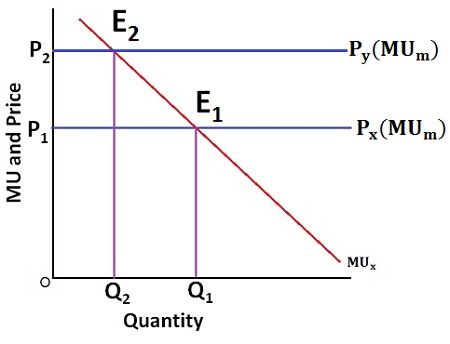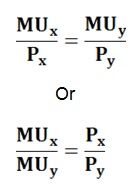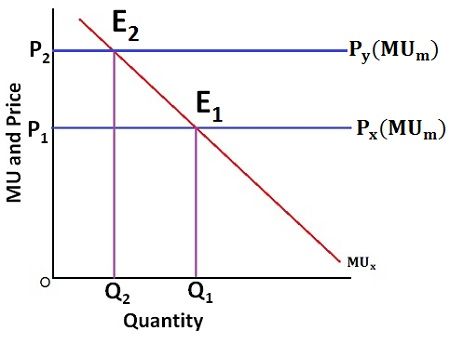Definition: The Cardinal approach to Consumer Equilibrium posits that the consumer reaches his equilibrium when he derives the maximum satisfaction for given resources (money) and other conditions. A consumer is said to be highly satisfied when he allocates his expenditure in such a way that the last unit of money spent on each commodity yields the same level of utility.
The concept of how consumer reaches his equilibrium can be further comprehended through the one-commodity model and multiple commodity model. In one commodity model, the consumer equilibrium is determined when he consumes a single commodity while in the multiple commodity model, the consumer equilibrium is determined when he consumes two or more commodities.
- Consumer’s Equilibrium – One Commodity Model: Suppose a consumer with a given amount of resources (money) consumes a single commodity, say X. For a consumer, both his income and commodity X will have respective utilities and he can either retain his income in the form of asset or can exchange it for the commodity X. If the marginal utility of commodity X (MUx) is greater than the marginal utility of money (Mum), then a utility-maximizing consumer will exchange his money income for a commodity.Based on the assumption, the marginal utility of a commodity is said to be declining with each successive unit and whereas the marginal utility of money remains constant, therefore the consumer will spend his money income on commodity X as long as MUx > Px(Mum). The Px is the price of the commodity and Mum is equal to one. Thus, the consumer reaches his equilibrium when,

Alternatively,


As per the graph, Px (Mum) is the horizontal line which shows the constant utility of money, whereas the MUx is a downward sloping curve which shows the diminishing marginal utility of commodity X. The Px(Mum) line and Mux curve intersect at point E, which indicates that at quantity OQx, MUx = Px(Mum). Therefore, the consumer is said to be in equilibrium.Any point above E, let’s say at M, the MUx > Px(Mum) the consumer will exchange money for commodity X since the marginal utility of the commodity is greater than the marginal utility of money, his satisfaction level will increase. Whereas any point below the equilibrium point “E,” the consumer loses utility and hence can compensate by reducing his consumption of commodity X.
- Consumer’s Equilibrium – Multiple Commodity Model: The single commodity model is based on the unrealistic assumption that the consumer consumes a single commodity. But, however, in real life, the consumer consumes a large number of goods and services. This model talks about how the consumer consuming multiple commodities reaches his equilibrium.It is assumed that the consumer has a limited money income and that the utility derived from multiple commodities are subject to diminishing returns. Also, several commodity yields different levels of marginal utility, such as some yield higher MU while others yield less MU as compared to the others. Thus, the rational and utility-maximizing consumer will select commodities on the basis of their utilities. This means the consumer will first buy those commodities which yield the highest utility, then the second highest and so on.
The consumer will allocate his expenditure in accordance with the MU of the commodities. He will continue to switch his expenditure from one commodity to another until he reaches a stage where last penny spent on each commodity yields the same utility. This is called as the Law of Equi-Marginal Utility.
Let’s understand the consumer’s equilibrium in the case of multiple commodity. Suppose a consumer consumes two commodities, say X and Y for the given level of his income and other conditions. Following the equilibrium rule of the single commodity model, the consumer will allocate his income in both the commodities in such proportion that:
 On the basis of the assumption that MU of money remains constant, a consumer reaches his equilibrium:
On the basis of the assumption that MU of money remains constant, a consumer reaches his equilibrium: The above equation can be rewritten as:
The above equation can be rewritten as:

Thus, as per the figure, the consumer reaches his equilibrium when the Mu derived from the each unit of expenditure on two commodities X and Y is the same.
Hence, the theory of consumption is based on the notion that consumer aims at maximising his utility for the amount of money spend on the goods and services. And the consumer reaches his equilibrium when he derives the maximum satisfaction from his consumption

Ahumuza Gilbert says
Good review of the topic
Ahumuza nobert says
Good notes
FRANCIS MWONGELI says
very smart work